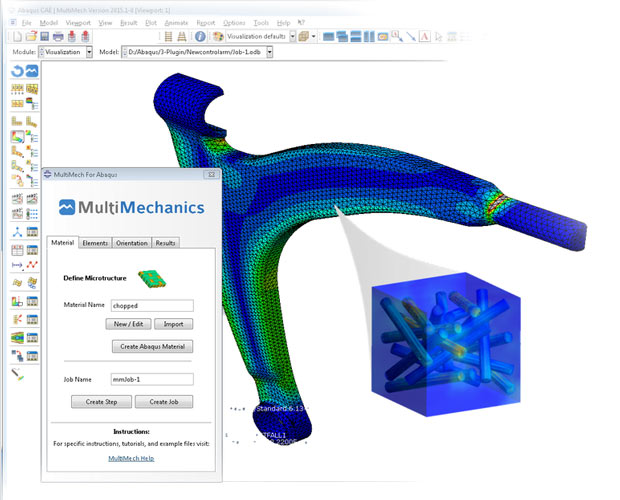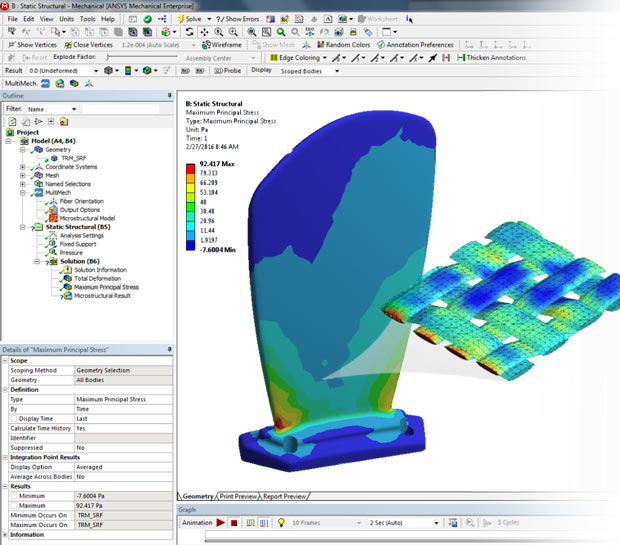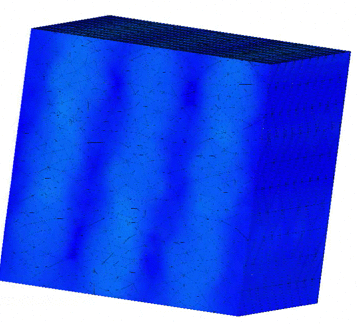
This image shows MultiMech for Dassault Systèmes’ SIMULIA Abaqus/CAE finite element modeling, visualization and process automation solution. MultiMech is also available as a standalone tool, and the company is working to embed MultiMech directly into other CAE software platforms. Image courtesy of MultiMechanics Inc.
Latest News
May 11, 2016
MultiMechanics Inc., a provider of CAE software for the analysis of advanced materials, has jointly announced with ANSYS Corp. the integration of its MultiMech composites and advanced materials structural analysis software within the ANSYS Workbench simulation platform. The company also recently announced a similar integration of MultiMech for Dassault Systèmes’ SIMULIA Abaqus/CAE finite element (FE) modeling, visualization and process automation solution. MultiMechanics is also a part of the Altair HyperWorks Partner Alliance.
 MultiMech for ANSYS allows designers and engineers to perform multiscale microstructural analyses of advanced composite parts and materials from directly inside of the ANSYS Workbench platform. Image courtesy of MultiMechanics Inc.
MultiMech for ANSYS allows designers and engineers to perform multiscale microstructural analyses of advanced composite parts and materials from directly inside of the ANSYS Workbench platform. Image courtesy of MultiMechanics Inc.MultiMech for ANSYS offers an FEA (finite element analysis) material modeling approach called TRUE Multiscale technology to predict complex failure mechanisms observed in advanced materials on the microstructural level. The MultiMech solver, explains the company, efficiently and simultaneously links the finite-element global-scale structure to finite-element local-scale RVEs (representative volume elements), which gives users “extremely accurate results and unmatched level of understanding” of your material’s behavior.
 This image shows MultiMech for Dassault Systèmes’ SIMULIA Abaqus/CAE finite element modeling, visualization and process automation solution. MultiMech is also available as a standalone tool, and the company is working to embed MultiMech directly into other CAE software platforms. Image courtesy of MultiMechanics Inc.
This image shows MultiMech for Dassault Systèmes’ SIMULIA Abaqus/CAE finite element modeling, visualization and process automation solution. MultiMech is also available as a standalone tool, and the company is working to embed MultiMech directly into other CAE software platforms. Image courtesy of MultiMechanics Inc.Using MultiMech for ANSYS, users can create and test composites with multiple types of reinforcement, including woven, braided, particulates as well as continuum and chopped fibers. It can be used to predict structural failure based on such microstructural design variables as fiber orientation and volume fraction. Engineers can use MultiMech to model multiple damage mechanisms, such as resin cracking, fiber breaking, fiber-resin deboning and ply delamination, simultaneously. When using automated processes to generate, mesh and analyze microstructural models, users have full control over microstructural design variables.
Among the features MultiMech for ANSYS provides are an automatic microstructural FE model generator, a two-way coupled multiscale implicit and explicit FE solver, an advanced crack algorithm to predict crack initiation and propagation as well as other preprocessing and post-processing functions. Additional features include one-click virtual material testing capabilities, additive manufacturing simulation and integration with injection molding orientation data. For modeling of short fiber composites, MultiMech integrates with and imports fiber orientation data from tools like Moldex3D and Moldflow.
 With MultiMech for ANSYS, engineers can model multiple damage mechanisms such as resin cracking, fiber breaking, fiber-resin deboning and ply delamination from within ANSYS simultaneously. The software comes with an advanced crack algorithm for predicting crack initiation. Image courtesy of MultiMechanics Inc.
With MultiMech for ANSYS, engineers can model multiple damage mechanisms such as resin cracking, fiber breaking, fiber-resin deboning and ply delamination from within ANSYS simultaneously. The software comes with an advanced crack algorithm for predicting crack initiation. Image courtesy of MultiMechanics Inc.With the MultiMech for ANSYS Workbench integration, says MultiMechanics, you can add a realistic MultiMech material to a new or existing ANSYS model as quickly as you could fill out a material card. Since MultiMech develops damage mechanisms to capture the physics of how composite materials interact and fail, it eliminates the need to use curve fitting to model a composite’s non-linear behavior.
“We are very excited to release this tool,” said Flavio Souza, chairman and CTO of MultiMechanics in the press announcement. “Such close partnership with ANSYS has enabled us to embed MultiMech in an intuitive and native workflow within ANSYS Workbench. This is truly a 10x improvement especially when it comes to user experience and accurate prediction of failure in advanced materials.”
“Making use of the open architecture of the ANSYS simulation platform to deliver their TRUE Multiscale technology, MultiMechanics is opening new doors to multiscale material modeling,” said Richard Mitchell, lead product marketing manager for the ANSYS Structural Mechanics product line, in the press announcement. “Combining ANSYS’ leading simulation platform with MultiMechanics’ powerful multiscale technology will give customers the ability to concurrently couple macro-scale events with sub-scale calculations in a single simulation.”
In addition to the versions of MultiMech for ANSYS and Abaqus, MultiMech is available as a standalone application. An API (applications programming interface) for connecting MultiMech to third-party CAE systems is also offered. The company reports that it is working to integrate MultiMech with more CAE platforms.
MultiMechanics says that MultiMech for ANSYS will soon be available to users through the ANSYS App Store on the ANSYS Customer Portal. For more information on the MultiMech for ANSYS integration, click here.
Watch a video on MultiMech for ANSYS.
Request a trial of MultiMech for ANSYS.
Go here for details on MultiMech for Abaqus.
Watch a video on MultiMech for Abaqus.
Request a trial of MultiMech for Abaqus.
Download the MultiMechanics brochure.
See why DE’s editors selected MultiMech for ANSYS as their Pick of the Week.
Sources: Press materials received from the company and additional information gleaned from the company’s website.
Subscribe to our FREE magazine, FREE email newsletters or both!
Latest News
About the Author
Anthony J. Lockwood is Digital Engineering’s founding editor. He is now retired. Contact him via [email protected].
Follow DERelated Topics






